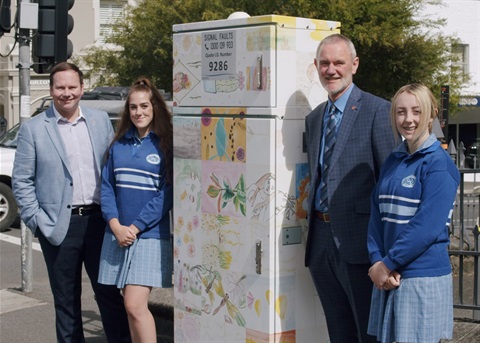
The City of Launceston's public art project Electric Botany has been named a finalist in the Australian Street Art Awards, which are due to be presented in Queensland on March 2.
Electric Botany has involved Tasmanian artists painting traffic signal boxes across Launceston, using the works of late Australian botanical illustrator Margaret Stones as inspiration.
The group of creatives was invited to study the extensive collection of Stones' work held by Launceston's Queen Victoria Museum and Art Gallery before being assigned a traffic signal box to bring their interpretation of Stones' work to life.
Each painting is unique, with results varying from realistic works through to colourful abstractions. While some of the traffic signal boxes were painted in situ, others have been wrapped in artworks prefabricated by local secondary schools.
These prefabricated works were prepared by more than 200 students who sketched their works on paper using watercolour pencils. The drawings were photographed and transferred to adhesive wraps which were then fitted to signal boxes.
Drawing workshops were also held at last year's Junction Arts Festival to enable Launceston residents to contribute to the Electric Botany project. These works will be applied to a cabinet in Charles Street in coming weeks. In total, 51 decorated signal boxes form an art trail, stretching from the CBD along Invermay Road to Mowbray and as far as the West Tamar Highway and Prospect.
Maps were made available at the Launceston Visitor Information Centre, and online, to guide people along the art trail and to profile the artists involved.
Launceston Mayor Albert van Zetten said Electric Botany was now a contender in the Best Street Art Trail category of the Australian Street Art Awards.
"This project has been a team effort involving so many different people and I'm delighted it's been nominated for an award," Mayor van Zetten said.
"The project has involved a range of talented Tasmanian artists and six local schools, the Queen Victoria Museum and Art Gallery and many more.
"I know from the feedback I've received from members of the public that these works have brightened a lot of people's days and given people a new appreciation for the artistic talent we have here in Northern Tasmania."
Launceston Deputy Mayor Danny Gibson said there was a growing appetite in Launceston for public art projects.
"It's been exciting to see this project grow from the idea stage to being realised on Launceston's streets," Cr Gibson said.
"It's a credit to the artists involved and whether the project ultimately takes out an award or not, Electric Botany has been a winner in the eyes of the community. "More than simply bringing smiles to people's faces, public art projects have real benefits for contemporary cities.
"They can build community networks, create pathways for artists, enhance liveability and create new opportunities in destination tourism."






